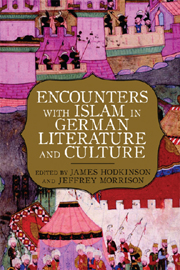Book contents
- Frontmatter
- Contents
- Acknowledgments
- Introduction
- 1 “cristen, ketzer, heiden, jüden”: Questions of Identity in the Middle Ages
- 2 Wolfram von Eschenbach, Islam, and the Crusades
- 3 Perverted Spaces: Boundary Negotiations in Early-Modern Turcica
- 4 Enlightenment Encounters the Islamic and Arabic Worlds: The German “Missing Link” in Said's Orientalist Narrative (Meiners and Herder)
- 5 Goethe, Islam, and the Orient: The Impetus for and Mode of Cultural Encounter in the West-östlicher Divan
- 6 Moving beyond the Binary? Christian-Islamic Encounters and Gender in the Thought and Literature of German Romanticism
- 7 Forms of Encounter with Islam around 1800: The Cases of Johann Hermann von Riedesel and Johann Ludwig Burckhardt
- 8 Displacing Orientalism: Ottoman Jihad, German Imperialism, and the Armenian Genocide
- 9 German-Islamic Literary Interperceptions in Works by Emily Ruete and Emine Sevgi Özdamar
- 10 Dialogues with Islam in the Writings of (Turkish-)German Intellectuals: A Historical Turn?
- 11 Michaela Mihriban Özelsel's Pilgrimage to Mecca: A Journey to Her Inner Self
- 12 Intimacies both Sacred and Profane: Islam in the Work of Emine Sevgi Özdamar, Zafer Şnocak, and Feridun Zaimoğlu
- 13 Encountering Islam at Its Roots: Ilija Trojanow's Zu den heiligen Quellen des Islam
- 14 The Lure of the Loser: On Hans Magnus Enzensberger's Schreckens Männer and Ian Buruma's Murder in Amsterdam
- Notes on the Contributors
- Index
3 - Perverted Spaces: Boundary Negotiations in Early-Modern Turcica
Published online by Cambridge University Press: 05 February 2013
- Frontmatter
- Contents
- Acknowledgments
- Introduction
- 1 “cristen, ketzer, heiden, jüden”: Questions of Identity in the Middle Ages
- 2 Wolfram von Eschenbach, Islam, and the Crusades
- 3 Perverted Spaces: Boundary Negotiations in Early-Modern Turcica
- 4 Enlightenment Encounters the Islamic and Arabic Worlds: The German “Missing Link” in Said's Orientalist Narrative (Meiners and Herder)
- 5 Goethe, Islam, and the Orient: The Impetus for and Mode of Cultural Encounter in the West-östlicher Divan
- 6 Moving beyond the Binary? Christian-Islamic Encounters and Gender in the Thought and Literature of German Romanticism
- 7 Forms of Encounter with Islam around 1800: The Cases of Johann Hermann von Riedesel and Johann Ludwig Burckhardt
- 8 Displacing Orientalism: Ottoman Jihad, German Imperialism, and the Armenian Genocide
- 9 German-Islamic Literary Interperceptions in Works by Emily Ruete and Emine Sevgi Özdamar
- 10 Dialogues with Islam in the Writings of (Turkish-)German Intellectuals: A Historical Turn?
- 11 Michaela Mihriban Özelsel's Pilgrimage to Mecca: A Journey to Her Inner Self
- 12 Intimacies both Sacred and Profane: Islam in the Work of Emine Sevgi Özdamar, Zafer Şnocak, and Feridun Zaimoğlu
- 13 Encountering Islam at Its Roots: Ilija Trojanow's Zu den heiligen Quellen des Islam
- 14 The Lure of the Loser: On Hans Magnus Enzensberger's Schreckens Männer and Ian Buruma's Murder in Amsterdam
- Notes on the Contributors
- Index
Summary
Nach dem Mittag-Essen einen Tanz durch 2. Buben (deren [die Türcken] zu ihrer Schande missbrauchen / welche verfluchte Unweiß in der Türckey sehr gemein
THUS READS A REVEALING EXCERPT from Stefan Gerlach's Tagebuch that spans the years 1573 to 1578. In 1674 this chronicle was finally published by a grandson of the author who had traveled to Constantinople, the capital of the Ottoman Empire. In his capacity as court preacher in a German diplomatic mission, Gerlach describes the post-luncheon entertainment provided by two young male dancers. These dancers would also be expected to fulfill sexual requests—a vice that is commonly practiced in Turkey, according to Gerlach.
According to German language turcica published between 1453 and approximately 1700, Ottoman sexual perversion and vice was commonplace. Furthermore, we repeatedly find images that link the Muslim as sexual pervert to images of him as religious fraudster, images that are in turn inseparable from the early-modern construction of the antagonistic Other. As this chapter will argue, both of these representations are directly related to the erection and defense of boundaries and space.
After the seventeenth century, a number of factors, including the West's growing military and political superiority, the Western reception of the Arabian Nights (with their “exotic-erotic” implications), and Enlightenment concepts of religious tolerance, together engendered momentous shifts in the portrayal of Islamic cultures. This chapter, however, will explore the relationship between religion, sex, and space in turcica published in the time between the so-called Fall of Constantinople and the 1680s, and how the topoi produced herein interact to construct a particular picture of the Muslim as deviant / Muslim as religious fraudster.
- Type
- Chapter
- Information
- Encounters with Islam in German Literature and Culture , pp. 55 - 72Publisher: Boydell & BrewerPrint publication year: 2009



